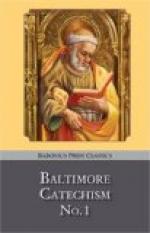The marks of the Church are necessary also because the Church must be a visible Church, that all men may be able to see and know it; for Our Lord said, “He that will not hear the Church, let him be to thee as the heathen and the publican.” (Matt. 18:17). Heathens were those who worshipped false gods. Publicans were men who gathered the taxes from the Jews for the Romans; they were generally very cruel to the people, and were much hated and despised by them. Therefore Our Lord meant: if anyone will not obey the Church, you should avoid him as you avoid the heathens and the publicans, whom you despise. Now no one can be blamed for not obeying a church that is invisible and unknown. Therefore the true Church must be a visible body and easily known to all who earnestly seek it as the Church of Christ. But if some shut their eyes and refuse to look at the light of truth, ignorance will not excuse them; they must be blamed and fall under the sentence of Our Lord.
134 Q. From whom does the Church derive its undying life and infallible authority? A. The Church derives its undying life and infallible authority from the Holy Ghost, the spirit of truth, who abides with it forever.
135 Q. By whom is the Church made and kept One, Holy, and Catholic? A. The Church is made and kept One, Holy, and Catholic by the Holy Ghost, the spirit of love and holiness, who unites and sanctifies its members throughout the world.
Lesson 13 ON THE SACRAMENTS IN GENERAL
This lesson does not speak of any Sacrament in particular, but upon all the Sacraments taken together. It explains what we find in all the Sacraments.
136 Q. What is a Sacrament? A. A Sacrament is an outward sign instituted by Christ to give grace.
Three things are necessary to make a Sacrament. There must be: (1) “An outward,” that is, a visible, “sign”; (2) this sign must have been instituted or given by Our Lord; (3) it must give grace. Now, a sign is that which tells us that something else exists. Smoke indicates the presence of fire.
A red light on a railroad tells that there is danger at the spot. Therefore, the outward signs in the Sacraments tell us that there is in the Sacraments something we do not see and which they signify and impart. For example, the outward sign in Baptism is the pouring of the water on the head of the person to be baptized, and the saying of the words. Water is generally used for cleaning purposes. Water, therefore, is used in Baptism as an outward sign to show that as the water cleans the body, so the grace given in Baptism cleans the soul. It is not a mere sign, for at the very moment that the priest pours the water and says the words of Baptism, by the pouring of the water and saying of the words with the proper intention the soul is cleansed from Original Sin; that is, the inward grace is given by the application of the outward sign. Again, in Confirmation the outward sign is the anointing with oil, the Bishop’s prayer, and the placing of his hands upon us. Now what inward grace is given in Confirmation? A grace which strengthens us in our faith. Oil, therefore, is used for the outward sign in this Sacrament, because oil gives strength and light.




